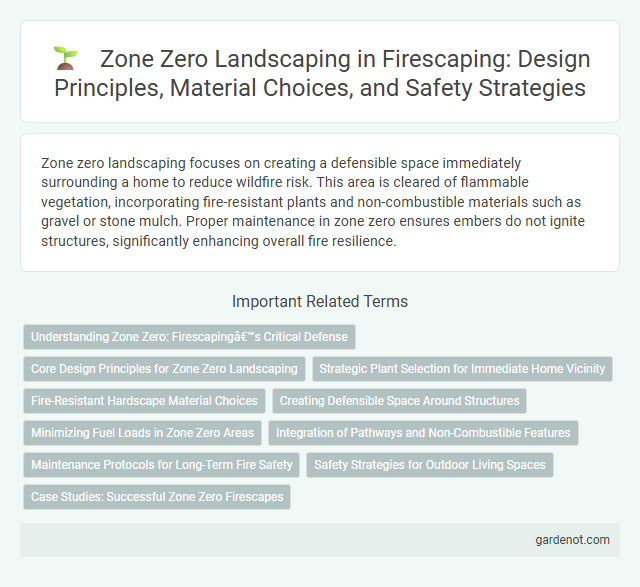Zone zero landscaping focuses on creating a defensible space immediately surrounding a home to reduce wildfire risk. This area is cleared of flammable vegetation, incorporating fire-resistant plants and non-combustible materials such as gravel or stone mulch. Proper maintenance in zone zero ensures embers do not ignite structures, significantly enhancing overall fire resilience.
Understanding Zone Zero: Firescaping’s Critical Defense
Zone Zero refers to the immediate area surrounding a structure, typically within five feet, where all combustible materials are removed to create a critical fire-resistant buffer. This zone is essential in firescaping because it significantly reduces the risk of ignition from radiant heat or direct flame contact during wildfires. Implementing proper Zone Zero landscaping, such as using non-flammable materials and maintaining clear, low-lying vegetation, enhances a building's defense against fire intrusion.
Core Design Principles for Zone Zero Landscaping
Zone Zero landscaping emphasizes using fire-resistant plants and non-combustible materials within five feet of structures to create a defensible space. Core design principles include maintaining low vegetation density, incorporating hardscape elements like gravel or stone, and ensuring proper spacing between plants to reduce fuel continuity. These strategies effectively minimize ignition risk and enhance home protection in wildfire-prone areas.
Strategic Plant Selection for Immediate Home Vicinity
Strategic plant selection in Zone Zero landscaping emphasizes using fire-resistant species with low fuel moisture content to reduce wildfire risk near the home. Prioritizing native succulents, deciduous shrubs, and well-irrigated herbaceous plants creates defensible space while maintaining aesthetic appeal. Proper spacing and maintenance of these plants are essential to prevent fire spread and protect the immediate home vicinity.
Fire-Resistant Hardscape Material Choices
Zone zero landscaping emphasizes fire-resistant hardscape materials such as concrete, stone, and brick to create effective defensible spaces around structures. These non-combustible surfaces reduce the risk of ignition by minimizing flammable vegetation near building foundations. Incorporating fire-resistant patios, walkways, and retaining walls enhances overall property safety during wildfire events.
Creating Defensible Space Around Structures
Zone zero landscaping involves creating a critical defensible space around structures by removing combustible vegetation and using non-flammable materials such as gravel or stone. This immediate zone, typically within 5 feet of buildings, reduces fire intensity and prevents direct flame contact with structures. Maintaining this clear area is essential to enhance wildfire resistance and protect property from advancing fires.
Minimizing Fuel Loads in Zone Zero Areas
Zone zero landscaping involves strategically reducing vegetation density and selecting fire-resistant plants to minimize fuel loads near structures. Utilizing non-combustible materials such as gravel, stone, or concrete further decreases the risk of ignition. Maintaining a well-irrigated, low-profile ground cover in this critical area ensures optimal defensible space to protect homes from wildfire threats.
Integration of Pathways and Non-Combustible Features
Zone zero landscaping emphasizes incorporating non-combustible materials such as concrete, gravel, and stone in pathways to create effective defensible space near structures. The integration of these pathways not only reduces fuel for wildfires but also directs foot traffic safely away from vulnerable areas. Utilizing fire-resistant features in zone zero enhances property protection and supports overall fire mitigation strategies.
Maintenance Protocols for Long-Term Fire Safety
Zone zero landscaping requires rigorous maintenance protocols, including regular removal of dead vegetation, pruning of lower tree branches, and ensuring all plants remain well-hydrated to minimize fire fuel. Consistent inspection schedules help detect and address potential fire hazards early, while using fire-resistant plants supports sustained fire safety. Effective irrigation management and debris clearance are critical for maintaining a defensible space that enhances long-term fire resilience.
Safety Strategies for Outdoor Living Spaces
Zone zero landscaping focuses on creating a defensible space immediately surrounding a home, using fire-resistant plants and hardscape materials to minimize ignition risks. Incorporating non-combustible ground covers, maintaining proper plant spacing, and eliminating dead vegetation are key safety strategies for outdoor living areas. Implementing ember-resistant vents and strategically placing patios and decks help protect structures while preserving aesthetic appeal.
Case Studies: Successful Zone Zero Firescapes
Case studies of successful Zone Zero firescapes demonstrate strategic planting of fire-resistant vegetation within five feet of buildings, significantly reducing wildfire ignition risks. Implementing non-combustible materials like gravel or stone mulch in this critical zone enhances ember defense and firebreak effectiveness. Data from these projects highlight improved home survivability rates and reduced maintenance demands, underscoring the importance of Zone Zero landscaping in comprehensive defensible space creation.
Zone zero landscaping Infographic

 gardenot.com
gardenot.com